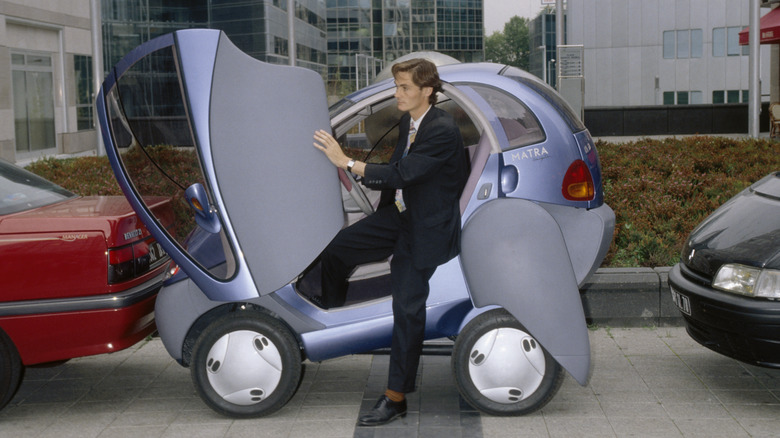This Renault Concept Car Was Early To The Compact EV Party
Part and parcel of nearly every electric vehicle (EV) is its diminutive size. It makes sense since less overall size equals less weight, thus less for the battery to move down the road. Compared to the massive metallic land yachts of the pre-1973 OPEC oil crisis, even Teslas are downright "compact."
While the actual move towards EVs began with that same crisis, the history of battery-powered cars goes back much further into automotive antiquity than you might realize. Given how far back it goes, it's interesting that the Toyota Prius — the world's first mass-produced gas-electric hybrid vehicle – didn't hit the market until 1997. And it took more than a decade – 2010 to be specific — for the first commercial plug-in hybrid (Chevy Volt) and mass-market all-electric vehicle (Nissan's LEAF) to hit the streets.
So it might come as a shock to many car enthusiasts, especially those in America, that "little" French car maker Renault (which has been around since 1898) rolled out a concept car years before all the hybrid hoopla, one that was not only wholly electric but redefined what a "compact" car could be.
Renault unveiled the Zoom at the 1992 Paris Motor Show as a city runabout that could easily slip through hectic traffic in and around urban landscapes while fitting into almost any open parking gap encountered on a typical European street. Designed in conjunction with Matra, this two-seater looks like an egg. It previously helped Renault create the almost (but not quite) equally odd, two-door multipurpose minivan Avantime, as well as its own quirky three-seat Murena coupe.
This incredible shrinking EV could Zoom
Keeping with the bizarre nature of Renault's PR slant (people dressed in weird spacey spandex), this egg had scissor doors that lifted up and not out, further increasing its close-quarter parking capabilities. Thanks to a completely plastic body, the entire thing weighed only 1,764 pounds. The Zoom had a standard wheelbase of just over 104 inches but was equipped with an innovative modular retractable wheelbase that shrank the car down an extra 14 inches (to 90.5 inches) if one found themselves in a tight spot.
Remember, smaller equals lighter. The nickel-cadmium batteries were reportedly 90% recyclable and accounted for nearly 772 pounds of the car's total weight. According to Renault, the EV had a range of 160 miles, could accelerate (if you want to call it that) from zero to 31 mph in six seconds, and could zoom at a top speed of 75 mph. Other sources peg the range at only 93 miles. Whatever the case, this wasn't a drag racer or countryside tourer, to be sure.
It had an onboard Carminat navigation system embedded in the seat that opened like a flip phone while a display screen popped open on the dashboard. The system also had an integrated hands-free telephone with controls for a CD player built into the steering wheel.
And while this well-rounded (yes, we went there) concept was never made, you can see how some of its design work evolved into a vehicle that Renault did mass produce — the Twizy.
